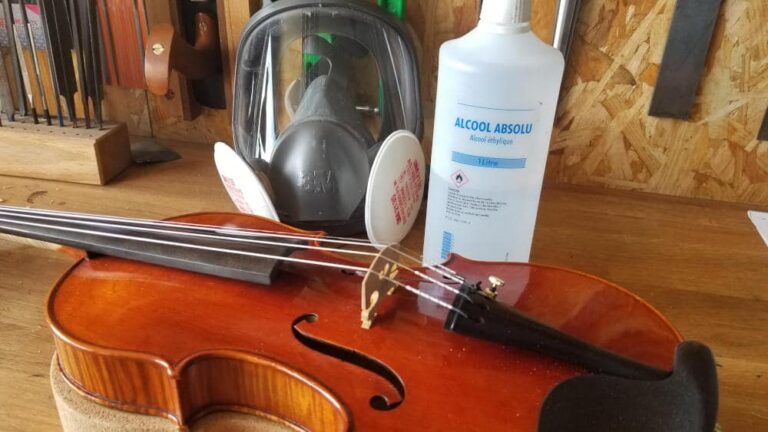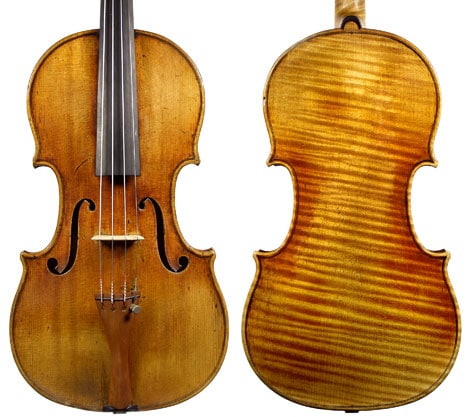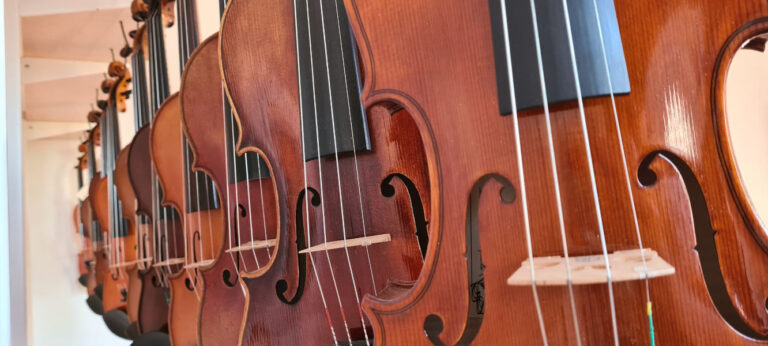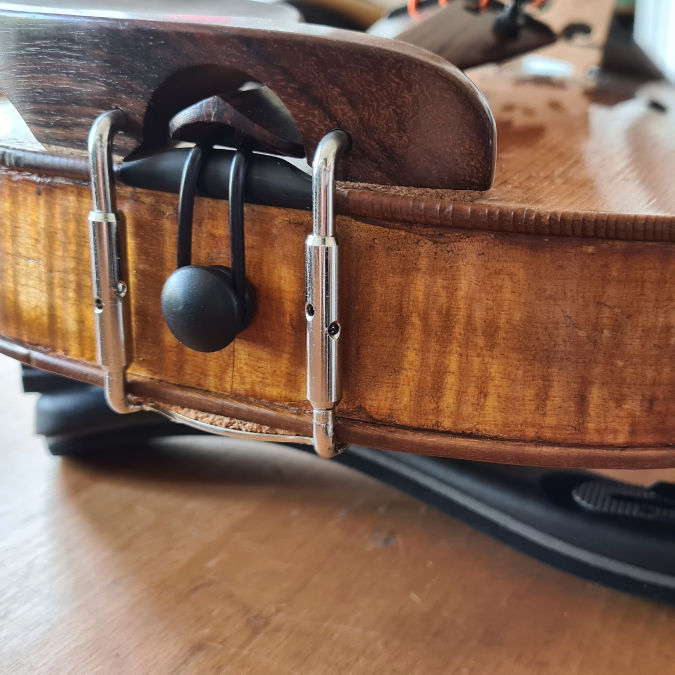Tuning your violin is an important step in learning the instrument and training your ear. What's more, it's an essential skill for playing in the best possible conditions in any ensemble. Here are a few tips to help you tune your violin, viola or cello.
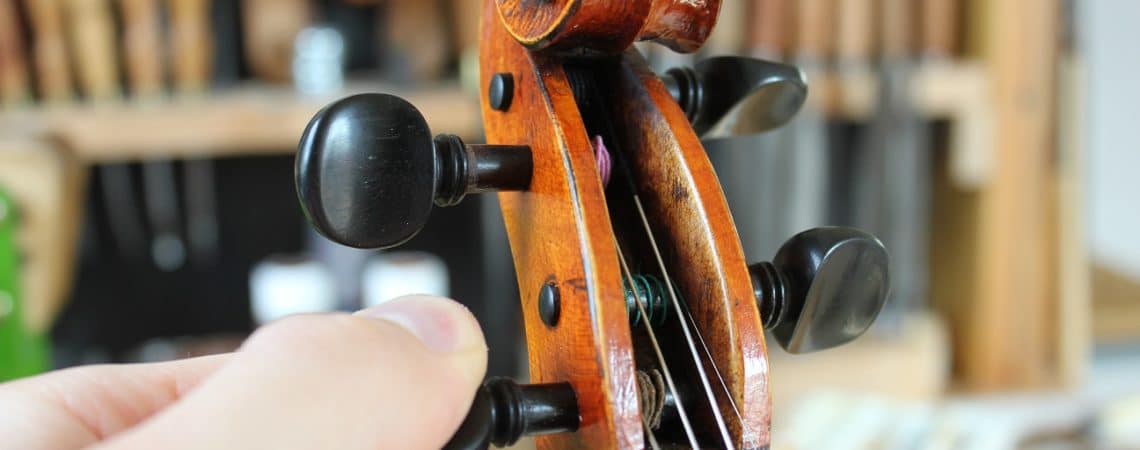
What is violin tuning?
Having a tuned instrument means that all its strings played open are at precise frequency intervals. This means we can play the right notes in the right places on the neck. This precision is essential for playing in harmony in an orchestra, and for avoiding as much as possible the dissonance created by overly approximate tunings.
So, as musicians, we use pegs to influence these distances between notes. The process of tuning a violin is carried out using the fine pegs and adjusters found on both sides of the instrument.
All the strings of the instruments in the quartet are tuned in fifths, which means that a tonal distance of five notes separates each string of the instrument. So, to get from the G string(G), which is the lowest on a violin, to the next, the D string(D), we can play the scale of G Major : G, A, B, C, D(five notes, hence the name quinte).

Tuning notes and frequencies
Here are the notes used to tune the quartet's instruments. The notes are described with their international names and their "standard" vibration frequency based on 440HzA .
The notes in the table below are arranged by frequency, from lowest to highest. In practice, however, strings are classified by gauge, the first being the thinnest string. This is why the first string is the highest-pitched and the fourth the lowest-pitched. Beware of confusion.
| Notes for tuning your violin, viola and cello | ||||
|---|---|---|---|---|
| Violin | G(G - 196Hz) | D(D - 294Hz) | A(A - 440Hz) | Mi(E - 660Hz) |
| Alto | C(C - 131Hz) | G(G - 196Hz) | D(D - 294Hz) | A(A - 440Hz) |
| Cello | C(C - 65Hz) | G(G - 98Hz) | D(D - 147Hz) | A(A - 220Hz) |
The practice of tuning
The practice of tuning can seem relatively complicated on the violin and similar instruments. The workings of the pegs, the creaking and high tension of the strings are necessarily intimidating. But it's nothing to be afraid of. With proper practice, good strings installed on a perfectly maintained instrument are a delight.
The pegs, although an archaic principle, allow fast, precise tuning and ultra-fast string changing. A simplicity of use not found on modern tuning machines. For, although they are precise, they require too much grinding to install the strings.
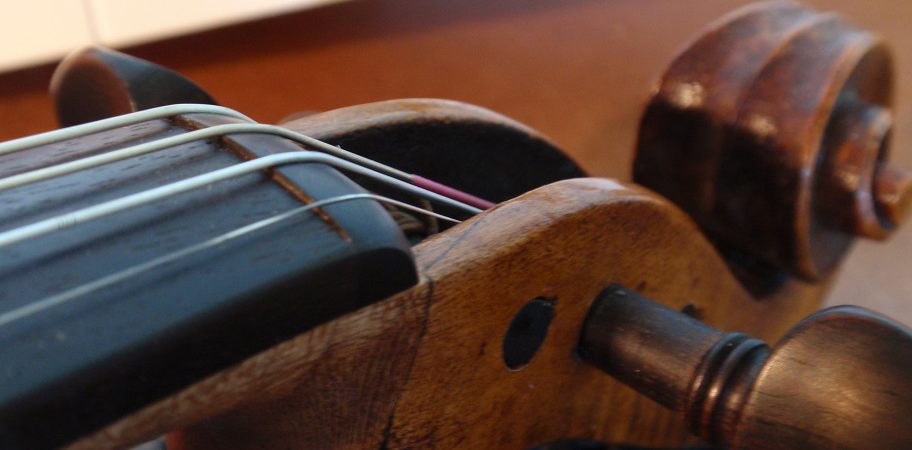
Tools for tuning your violin
Unless you have an absolute ear for music, the average person needs a reference for tuning. Nowadays, here are the tools we can use for tuning:
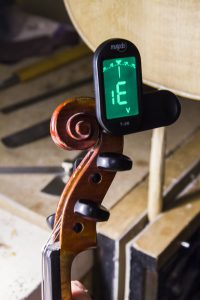
- Whistles: Whistles produce a reference note when we blow into them. Their timbre is sometimes confusing and they modulate according to the way you blow. Not recommended.
- Tuners: Tuners come in many forms, from dedicated boxes that can be more or less expensive depending on their options. Most offer different tuning modes: by instrument, chromatic or simultaneous(several strings together).
- Clip-on tuners: Same principle as the other tuners, but these are attached to the instrument and benefit directly from its vibration.
- Smartphones: All cell phones and tablets have applications(free or paid) for tuning your violin. Since they're always at hand, they're indispensable. I myself often use the gStrings app for Android, which is free and quite comprehensive.
Less portable accessories
- Another instrument: We can also use another instrument to tune with this one, usually the least easily tuned instrument is used as a reference(organ, piano, etc.).
- Grandma's landline phone. In fact, it'll give you the La you're looking for.
Finally, although these tools are useful, the ear will always have the final say on tuning according to the situation.
The tuners in the Lutherie d'Art boutique
I no longer offer tuners in my online store. However, you can find all tuners for violins and other instruments on Lutherie.art
How to tune your violin, viola or cello
The theory
The acoustic pitch of a string is defined by three parameters: length, diameter and tension. These work as follows:
- Vibrating length(tuning fork): This is the length of string in vibration when played. The greater the distance, the lower the note. This length is fixed and imposed by the saddle and bridge position. The fingers can be used to shorten this distance to create higher notes.
- String diameter: the larger the string diameter, the lower the note produced. It's easy to see that a G string on a violin is thicker than an E string. Strings set this parameter.
- Tension : There are several approaches to string tension, but only mechanical tension will interest us here. The greater the force exerted on the string, the higher the note.
How does this translate into tuning?
When we talk about tuning an instrument, we usually only mean influencing the tension. On violins, violas and cellos, we mainly use pegs to influence tension. In a nutshell, these are dense wooden cones that fit perfectly into a hole in the instrument's pegbox. The friction of the wood is too great for well-fitting pegs to be usable. That's why they're lubricated to strike the right balance between grip and fluidity.
There are also tensioners(or fine adjusters) sometimes installed on the tailpiece to provide more precise tuning by means of a screw. There are often four on student instruments, but advanced players prefer to use only one on the E string.
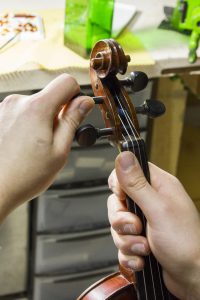
The art of violin tuning
Let's move on to the actual practice. If the rope is mounted and tightly wrapped around the ankle :
Preparation
- Place the instrument facing you on your lap(or between your knees for cellos).
- Next, get your tuning tool(if applicable).
Change note pitch
- Loosen the peg by rotating it to release its grip on the peg.
- Turn the peg to exert tension on the string to reach the desired note. The rope must always pass over the ankle, not under it. Viewed from the front, this corresponds to counter-clockwise.. Depending on the quality of the instrument pegs, this task may be more or less obvious,
- It's customary to always go up in pitch when tuning. If you go beyond the note, relax the string and then retension to reach it.
- If the peg doesn't turn or doesn't adhere well enough to the peg, a trip to the luthier will be mandatory(the use of soap or chalk to counteract or facilitate adhesion can also be done at home. If this is your choice, find out beforehand and apply very little of either ingredient).
Lock the note and adjust
- To lock the rope, simply push the peg gently back into its cavity. In addition, winding the rope against the wall of the peg allows you to force the blocking a little and prevent the peg from slipping. Be careful, however, not to force this practice, as the forces involved can split the pegboard.
- If your tailpiece is equipped with one, use its fine tuners for final pitch adjustments. These allow greater precision. It is still preferable to tune your instrument as accurately as possible using the pegs.
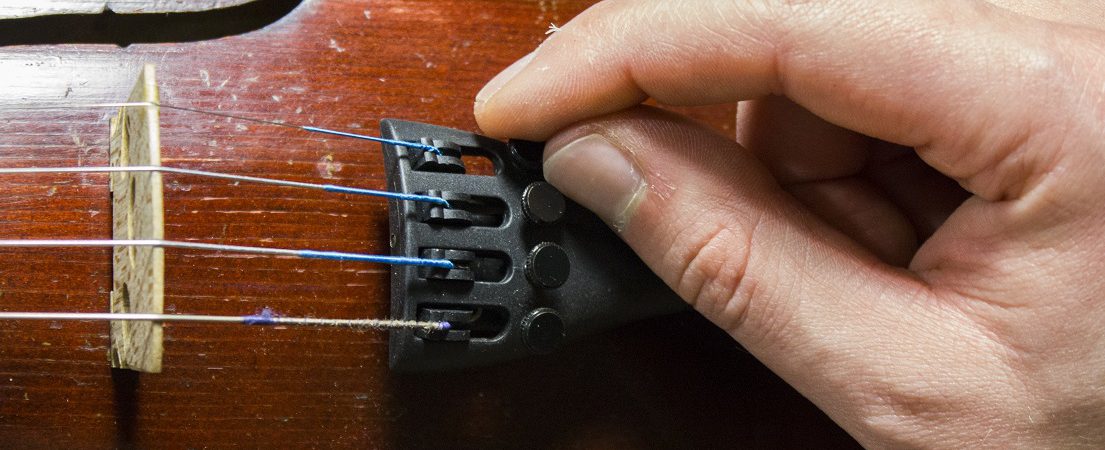
Tips for tuning your violin
When you're just starting out, there are many problems that can disrupt the tuning of your instrument. Here are a few tips to help you solve the most common problems yourself, and get your instrument in tune.
- Never over-tension strings: this alters their lifespan and increases their chances of breaking. Indeed, beyond a tone and a half, the chances are very high.
- If you put all the strings on your instrument at the same time, you'll notice that the tuning is very unstable. You'll have to go over and over again to achieve stable notes. This is because the neck, the soundboard and the whole instrument bend under tension. That's why it's always advisable to change the strings one by one to avoid this inconvenience.
- New strings also take some time to stabilize. They produce a hoarse sound and go out of tune regularly. This experience lasts, depending on the model and playing time, from a few hours to a few days.
- Fine adjusters sometimes reach the end of their travel, making it impossible to tune your violin. In this case, simply loosen the adjustment screw completely, then re-tune with the dowel and finally complete the fine tuning with the turnbuckle.
- To take things a step further, there are also mechanical pegs that are highly precise and require no special maintenance. The Pegheds, Wittner and Planetary Pegs companies offer various models. Having them installed could radically change your life as a musician.
What keeps you from tuning your violin: F.A.Q.
Why does my string break during tuning?
Extreme tension is exerted at all times on the strings of a tuned violin, about 25kg distributed between each string. The E string alone bears a tension of around 10kg. Poor-quality, corroded or damaged strings are therefore more likely to break. The best models don't pose this problem, as their manufacturing processes and quality control are quite rigorous.
However, there are certain parts in contact with the rope that can shorten its service life:
- Firstly, a saddle that is too protruding and badly rounded, with string passages that are too narrow or poorly lubricated.
- This can also be due to dowels with unbeveled holes.
- A bridge that is not chamfered, with a string passage that is too narrow or poorly lubricated.
- Finally, turnbuckles and tailpieces with too sharp a claw. As in my topic here: The detail that kills synthetic strings
The sharp angles that may be present on these parts tend to bend or weaken the strings. This is relatively common if they are not properly prepared and maintained. These problems can be found on almost all low-end instruments, or those ordered over the Internet. Rounded, polished surfaces that the strings can conform to are necessary to prevent this type of accident.
And don't over-tension when tuning: above a tone and a half, the risk of breakage increases tenfold.
Why does my violin often go out of tune?
First of all, it's important to know that a string under tension continually goes out of tune over the course of its life. This is because the material of which it is made gradually relaxes. This phenomenon is almost imperceptible and generally has little effect on playing quality.
New strings are highly unstable from the moment they are tensioned, and will therefore often go out of tune during the first few hours.
Variations in temperature and humidity can also be a factor, to a greater or lesser extent depending on the type of string. Gut strings, for example, are very sensitive, while metal strings are indifferent. Finally, these variations have an influence on the wood of the instrument, which "breathes", thus changing the tuning.
Why won't my string stay in tune?
In fact, there are many sources of problems on an instrument that cannot be tuned.
- First of all, ill-fitting or slippery ankles.
- But it can also be a breathless harmony bar.
- Or a soundboard that's too thin or damaged.
- It can also be an ill-fitting soul.
- Likewise, a bent or broken bridge.
- The tailpiece attachment is too soft.
- Finally, it could also be a button that won't stay in place.
In all these cases, it's imperative to go and see the luthier.
More often than not, problems arise from pegs that are too slippery, or where the wood has shrunk due to low humidity. In this case, simply add a little chalk to the surfaces in contact with the peg to reinforce adhesion. On the other hand, if they adhere too much and emit a characteristic squeaking sound, they need to be lubricated with a little soap or kerosene. This is the traditional way luthiers adjust their fit.
Please also make sure you have mastered the tuning movement with the pegs. First pull the peg to release it, turning it towards you(loosening the string). Then turn it to the right tension and push it back without forcing.
Why did my bridge fall out when I was tuning it?
During tuning, the strings can pull the bridge forward and cause it to slide, throwing it against the instrument. A truly frightening experience. Contrary to popular belief, the bridge does not stick to the violin. In fact, it's only the pressure of the strings that holds it in place. To avoid these problems, check that the bridge feet are in contact with the soundboard. Usually, all you have to do is gently pull the bridge back to reposition it during tuning. I talk about this in this article: straightening your bridge without risk. You can also ask your teacher or luthier to give you a demonstration. They'll(probably) be happy to.
Finally, if a bridge can't hold its place and falls over every time you try to tune it, it's probably because its legs are damaged or its balance compromised. In such cases, you'll need to visit a luthier to have a new one carved.
[blog_posts items="1″ orderby="date " ids="9299″]
Get your violin tuned at the workshop
If you're still reluctant to tune your violin, there's nothing to be ashamed of: it's a gesture that can take time to develop and master. That's why, if you have the slightest problem, don't hesitate to ask for help from a professional teacher or violin maker. And remember, a short demonstration is sometimes worth a thousand words.
You can also contact me or drop in at the workshop for help or to show you how to do it properly.


